*** DISCONTINUED (NO LONGER AVAILABLE) ***
The Autism Spectrum Disorders IEP Companion provides programming guidance for some of the most significant communication, social, and behavioral challenges presented by students with ASD.
Each unit addresses a major deficit area. Each skill area is identified and explained, followed by a long-term goal and a series of short-term goals to build skills acquisition. The goals cover a wide range of ages and severity levels within the autism spectrum from early intervention to higher-functioning individuals and older clients.
The units and the skills addressed are:
• Communication—modality, apraxia/motor speech, single words, two-word combinations, echolalia, meaningfulness, asking and answering simple questions, following directions, concept acquisition, understanding verb tenses and personal pronouns, prosody, conversational rules, and ambiguous language
• Social Pragmatics—joint attention, turn-taking, initiation, play, topicalization, conversational discourse (e.g., negotiation, persuasion, humor), nonverbal communication, and presupposition
• Behavior—attention, noncompliance, task completion, perseveration, stereotypes, disruptive vocalizations, obsessive-compulsive tendencies, aggression, bolting, hygiene, and sleep disturbances
• Sensory—proprioceptive, vestibular, visual, auditory, tactile, olfactory, and gustatory
• Literacy—preliteracy, phonological awareness, phonics, sight-word recognition, reading fluency, reading comprehension, and written language
• Classroom Considerations—management of space, people, curriculum, materials, time, and emotion
• Transition—home to school, classroom to classroom, school to school, school to community, and school to work
Each goal has programming suggestions to make teaching visual, concrete, and understandable to children with ASD.

 Proud to be Canadian
Proud to be Canadian
